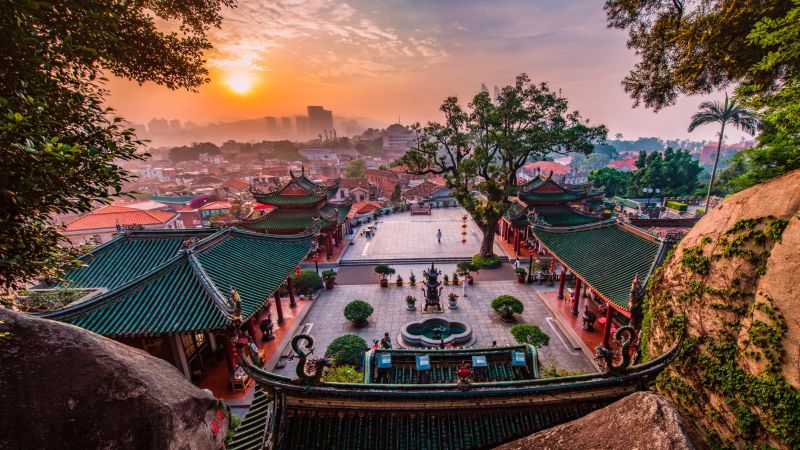Experience Tranquility: Discovering the Spiritual Essence of Qutan Temple Heritage

An Essential Guide to Visiting Qutan_Temple_Heritage
Nestled in the heart of Qinghai Province, Qutan Temple (瞿昙寺) stands as a testament to centuries of Buddhist devotion and architectural splendor. Often referred to as the “Little Forbidden City,” this remarkable site is a harmonious blend of Tibetan Buddhist traditions and Han architectural styles. With its roots tracing back over 600 years to the Ming Dynasty, the temple offers visitors a unique glimpse into the rich tapestry of cultural and religious history that defines this region.
As you approach the temple, you’ll be captivated by its stunning surroundings—majestic mountains and flowing rivers create a serene backdrop that enhances the temple’s spiritual ambiance. The intricate murals adorning its walls tell stories of faith and artistry, reflecting the temple’s significance as a revered pilgrimage site for Tibetans, Mongolians, and other ethnic groups who embrace Tibetan Buddhism.
This guide aims to provide international travelers with essential insights into visiting Qutan Temple, from its historical significance and architectural wonders to practical travel tips. Whether you are an architecture enthusiast, a history buff, or simply seeking a peaceful retreat, Qutan Temple promises an enriching experience that will linger in your heart long after your visit. Prepare to embark on a journey that transcends time and space, unveiling the beauty and depth of one of Qinghai’s most cherished cultural treasures.
In This Guide
- An Essential Guide to Visiting Qutan_Temple_Heritage
- The Rich History and Legends of Qutan_Temple_Heritage
- Main Highlights: What You Absolutely Can’t Miss
- Planning Your Visit: A Practical Guide
- Tickets: Prices, Booking, and Tips
- How to Get There: A Complete Transportation Guide
- Local Cuisine and Accommodation Nearby
- Frequently Asked Questions
- Final Thoughts on Your Trip
The Rich History and Legends of Qutan_Temple_Heritage
Nestled in the serene landscapes of Haidong City, Qinghai Province, Qutan Temple is not just a site of religious significance; it is a tapestry woven from over six centuries of history, culture, and artistry. Founded in 1392 during the Hongwu period of the Ming Dynasty, this majestic Tibetan Buddhist monastery—known as Zhuocang Lagodandai in Tibetan—was established as a gesture of loyalty to the Ming court by the founding monk, Sanluo Lama. His devotion was solidified when he presented horses to the emperor, leading to the temple’s designation and the bestowal of a golden plaque, a symbol of imperial favor.
The architecture of Qutan Temple is a striking testament to the blending of Han Chinese and Tibetan styles. Often referred to as the “Little Forbidden City,” its layout echoes that of Beijing’s imperial palace, featuring a grand central axis with multiple courtyards, halls, and corridors that exemplify the architectural brilliance of the early Ming period. The temple complex, covering an area of 1.5 hectares, is remarkably well-preserved, showcasing intricate murals and culturally significant relics that attract art enthusiasts and historians alike.
As the temple expanded in the early Yongle period, it became a vital cultural hub, with eunuchs and commanders commissioned to oversee its development. Among its many features, the Baoguang Hall and Vajra Hall stand out, both adorned with magnificent murals that mirror the artistic styles of the Renaissance, hinting at a fascinating cultural exchange. The temple’s fame grew, drawing followers from various ethnic groups, including Tibetans and Mongolians, who revered it as a sacred space.
The trials and tribulations of Qutan Temple are equally as compelling as its achievements. During the late Ming Dynasty, it faced turmoil with the rise of Li Zicheng’s forces, which significantly affected its population and attendance. Despite these challenges, the temple endured, continuing to serve as a vital repository of Tibetan Buddhist culture and an architectural marvel.
In the centuries that followed, the Qing Dynasty’s shifting focus led to a decline in imperial patronage for Qutan Temple. However, its significance remained intact, with local monks and practitioners striving to preserve its heritage. Today, Qutan Temple stands as a national key cultural relic, inviting visitors to explore its rich history and the legends that breathe life into its ancient walls.
For travelers seeking to immerse themselves in the essence of Qinghai, a visit to Qutan Temple offers not just a glimpse into the past but also a profound appreciation for the enduring legacy of Tibetan Buddhism and the architectural ingenuity of the Ming Dynasty. As you wander through its sacred halls, adorned with vibrant murals and steeped in history, you will find yourself transported to an era where faith and artistry intertwined, shaping the spiritual landscape of this remarkable region.

Qutan_Temple_Heritage.
Main Highlights: What You Absolutely Can’t Miss
Qutan Temple, a magnificent gem nestled in the Haidong region of Qinghai, offers an extraordinary blend of history, culture, and artistry that no traveler should miss. Here are the main highlights that make this destination a must-visit:
Architectural Marvel: The “Little Forbidden City”
Qutan Temple is often referred to as the “Little Forbidden City” due to its striking resemblance to the architectural style of Beijing’s imperial palaces. This Tibetan Buddhist monastery, constructed during the Ming Dynasty, showcases a layout that mirrors the grandeur of the Forbidden City. With its three distinct courtyards arranged along a central axis, visitors will find themselves enchanted by the Mountain Gate, Vajra Hall, and the impressive Qutan Temple Hall, among other significant structures.
Stunning Murals and Cultural Treasures
As you step inside, you’ll be greeted by a breathtaking array of murals that have stood the test of time for over 600 years. These vivid artworks, rich in color and detail, are not just aesthetically pleasing; they also narrate stories steeped in Buddhist teachings and history. Their intricate designs reflect the artistic influences of the era, providing a fascinating glimpse into the cultural exchanges that shaped this region.
Historical Significance
Founded in 1392 during the Hongwu period, Qutan Temple has been a pivotal site for Tibetan Buddhism in the region. It was established by Sanluo Lama, who sought imperial favor for the temple, leading to its growth and prominence. The temple has endured numerous historical events, including uprisings and changes in dynastic power, making it a crucial site for understanding the evolution of Tibetan Buddhist culture and architecture in China.
Spiritual Atmosphere
Qutan Temple is not only a tourist attraction but also a revered spiritual site for practitioners of Tibetan Buddhism. The serene environment, coupled with the temple’s majestic presence, invites visitors to reflect and appreciate the deep-rooted traditions that continue to thrive here. Engaging with the local monks and partaking in quiet contemplation adds a profound layer to your visit.
Accessibility and Visitor Information
Located approximately 21 kilometers south of Ledu District, the temple is easily accessible via public transportation or by car. While there is no admission fee, visitors are encouraged to respect the temple’s serene environment by adhering to local customs and etiquette. Aim to spend about 1-2 hours exploring the intricate details of this architectural masterpiece.
Engaging with Local Culture
As you plan your trip, consider extending your exploration to the surrounding area, where you can experience the diverse culture of Haidong. From traditional ethnic performances to local culinary delights, the region offers a rich tapestry of experiences that complement your visit to Qutan Temple.
In summary, Qutan Temple stands as a testament to the artistic and spiritual heritage of Qinghai. Its architectural splendor, historical significance, and vibrant murals make it an unforgettable destination for international travelers seeking to immerse themselves in the rich tapestry of Tibetan Buddhism and Ming Dynasty culture. Don’t miss the opportunity to discover this remarkable treasure on your journey through China!

Qutan_Temple_Heritage.
Planning Your Visit: A Practical Guide
Visiting Qutan Temple offers travelers a unique glimpse into the rich tapestry of Tibetan Buddhism and Ming Dynasty architecture. Nestled in the scenic Haidong region of Qinghai Province, this temple is often referred to as the “Little Forbidden City” due to its striking resemblance to the imperial palace in Beijing. Here’s a practical guide to ensure your visit is both enjoyable and enlightening.
Getting There
Location:
Qutan Temple is located approximately 21 kilometers south of Ledu District, Haidong City. The temple sits at the base of the Luohan Mountain and overlooks the picturesque Qutan River.
Transportation Options:
– By Air: The nearest major airport is Xining Caojiabao International Airport. From there, you can take an airport bus to Haidong City or rent a car for convenience.
– By Bus: Long-distance buses operate from Xining Bus Station to Ledu. The journey takes about 60 minutes and costs around 50 RMB.
– By Car: Renting a car is highly recommended for flexibility, as public transport options within Haidong can be limited.
When to Visit
Opening Hours:
Qutan Temple is open year-round from 9:00 AM to 5:00 PM. It is advisable to arrive early in the day to fully explore the temple complex without the crowds.
Recommended Sightseeing Time:
Plan to spend 1-2 hours at the temple to appreciate its architecture and murals.
What to Expect
Architecture and Layout:
The temple’s layout consists of three main courtyards arranged along a central axis, featuring the Mountain Gate, Vajra Hall, Qutan Temple Hall, and Baoguang Hall. The architecture displays a blend of Han and Tibetan styles, making it distinct among Tibetan Buddhist temples.
Murals and Art:
One of the highlights of Qutan Temple is its stunning murals, which date back over 600 years. The vibrant colors and intricate designs are reminiscent of Renaissance art, showcasing the unique cultural exchanges that have taken place over centuries.
Cultural Significance:
As a national key cultural relic protection unit, Qutan Temple holds immense historical and artistic value. It serves as a vital resource for understanding Tibetan Buddhist culture and the architectural styles of the Ming and Qing Dynasties.
Tips for Your Visit
- Respect Local Customs: As a sacred site, visitors are expected to maintain decorum. Dress modestly and avoid loud noises. Photography may be restricted in certain areas, so be sure to ask before taking pictures.
- Altitude Awareness: Haidong is situated at a high altitude, so be mindful of potential altitude sickness. Stay hydrated and consider acclimatizing in Xining before your visit.
- Weather Considerations: The weather can be unpredictable, with significant temperature variations between day and night. Bring warm clothing, even in summer.
Food and Accommodations
Local Cuisine:
Don’t miss the chance to try local dishes, such as Hand-grabbed Lamb and Niangpi, at nearby eateries. Exploring the local night market for snacks like Sweet Fermented Grains is also highly recommended.
Accommodation:
While options near the temple may be limited, consider staying in Ledu or Xining for a wider selection of hotels and guesthouses. Booking in advance is advisable, especially during peak travel seasons.
Final Thoughts
A visit to Qutan Temple is not just a journey through history; it’s an opportunity to immerse yourself in the spiritual heritage of Tibetan Buddhism. With its breathtaking architecture, rich murals, and serene surroundings, Qutan Temple promises an unforgettable experience for all who visit. Plan your trip thoughtfully, and you’ll leave with lasting memories of this cultural gem in Qinghai Province.

Qutan_Temple_Heritage.
Tickets: Prices, Booking, and Tips
Visiting Qutan Temple is a fascinating journey into the heart of Tibetan Buddhism and Ming Dynasty architecture. The good news for international travelers is that access to this stunning site is quite affordable.
Admission Fees
- Entry Cost: Admission to Qutan Temple is free, making it an excellent option for budget-conscious travelers eager to explore cultural heritage without the burden of entry fees.
Opening Hours
- Visiting Time: The temple is open daily from 9:00 AM to 5:00 PM. Make sure to arrive before 5:00 PM, as entry is not permitted after this time.
Booking and Access
- No Advance Booking Required: Since there is no admission fee, you do not need to book tickets in advance. Simply show up during operating hours.
- Getting There: Qutan Temple is located about 21 kilometers south of Ledu District. You can reach it easily by taking a local bus or hiring a taxi from nearby towns. If you prefer a more flexible schedule, consider renting a car for the best travel experience.
Tips for Your Visit
- Respect Local Customs: As Qutan Temple is a significant religious site, it’s essential to respect the local customs and etiquette. Keep noise to a minimum and refrain from littering.
- Photography: While capturing the beauty of the murals and architecture is tempting, be mindful of where photography is permitted within the temple grounds.
- Plan Your Visit: Allocate about 1 to 2 hours for your visit to fully appreciate the historical and artistic significance of the temple.
With its remarkable architecture and rich history, Qutan Temple promises to be a highlight of your travels in Qinghai. Enjoy your visit!
How to Get There: A Complete Transportation Guide
To reach Qutan Temple, an exquisite testament to Ming Dynasty architecture nestled in the scenic Haidong region of Qinghai Province, you can choose from various transportation options depending on your point of origin. Below is a comprehensive guide to help you navigate your journey to this cultural gem.
Getting to Qutan Temple
Arriving by Air
The nearest major airport is Xining Caojiabao International Airport (XNN), located approximately 71 kilometers north of Qutan Temple. Once you land, you have a couple of options to reach the temple:
-
Airport Shuttle Bus: There are shuttle buses that run between the airport and Xining city center. From there, you can catch a bus to Ledu District.
-
Taxi or Ride-Hailing Services: For a more direct and comfortable experience, consider taking a taxi or using a ride-hailing app. This option is more expensive but saves time.
Traveling by Train
If you prefer traveling by train, Xining has a well-connected railway station. You can take a train to Ledu Railway Station, which is the nearest train stop to Qutan Temple. Here’s how to continue from there:
- Local Transportation: Once at Ledu Railway Station, you can opt for a taxi or local minibus to reach Qutan Temple, which is about 20 kilometers south of Ledu.
By Long-Distance Bus
For budget-conscious travelers, taking a long-distance bus from Xining is a convenient option:
-
Bus from Xining: Head to the Xining Long-Distance Bus Station (opposite the train station) and catch a bus to Ledu. The journey takes approximately 60 minutes. Buses are frequent, but it’s advisable to check the schedule ahead of time.
-
Local Transit to Qutan Temple: Once in Ledu, you can take a taxi or a local bus for the remaining distance to Qutan Temple.
Car Rentals and Self-Driving
For those who enjoy the freedom of the open road:
-
Car Rentals: Renting a car is an excellent option, especially if you wish to explore the scenic beauty of Haidong at your own pace. Various rental agencies operate in Xining, and you can book in advance or upon arrival.
-
Self-Driving Directions: From Xining, follow Route 109 south to Ledu and then take the exit for Qutan Town. The temple is well-signposted once you approach the area.
Internal Transportation in Haidong
Once you’re in Haidong, getting around can be a bit challenging due to the scattered nature of attractions. Here are some suggestions:
-
Car Rentals: As mentioned earlier, renting a car can provide you with the flexibility to visit multiple sites in the region, including nearby cultural and natural attractions.
-
Chartered Services: If you’re traveling in a group, consider hiring a chartered vehicle for a more comfortable and efficient way to explore the area.
-
Local Buses: While public transportation exists, buses may not run frequently, so it’s best to plan your trips ahead of time.
Important Tips for Travelers
-
Altitude Sickness: Haidong is at a high altitude, so be prepared for possible altitude sickness. Take it easy upon arrival, stay hydrated, and consider consulting a doctor for preventive measures.
-
Weather Variability: The weather can be unpredictable, with significant temperature drops at night. Dress in layers and be sure to bring warm clothing, even in summer.
-
Cultural Respect: As Qutan Temple is a significant religious site, be respectful of local customs and dress appropriately when visiting.
With this guide in hand, you are well-equipped to embark on your journey to the historic and artistic marvel of Qutan Temple. Enjoy your travels through the enchanting landscapes of Qinghai!

Qutan_Temple_Heritage.
Local Cuisine and Accommodation Nearby
Exploring the Qutan Temple Heritage offers not just a glimpse into the rich tapestry of history and culture but also an opportunity to indulge in local culinary delights and find comfortable accommodations nearby.
Local Cuisine
1. Qinghai Noodles (Ga Mianpian and Paozhang Noodles)
After your temple visit, head to Ledu City for a delicious bowl of Qinghai noodles. Ga Mianpian, known for its unique flat shape, and Paozhang noodles, typically served in a rich broth, are must-tries. The local eateries often serve these dishes with a variety of toppings, such as tender meat and fresh vegetables, making for a hearty meal.
2. Hand-grabbed Lamb
A true Qinghai specialty, Hand-grabbed Lamb is a dish you won’t want to miss. The lamb is tender and seasoned with just the right amount of pepper and salt. Eating it with your hands adds a rustic charm, allowing you to savor the bold flavors in a traditional manner.
3. Niangpi
For a refreshing snack, try Niangpi, a smooth and chewy noodle-like dish served cold with chili oil, vinegar, and garlic sauce. Its sour and spicy flavor makes it a favorite among locals and visitors alike.
4. Sweet Fermented Grains
To round off your culinary adventure, indulge in Sweet Fermented Grains, a delightful dessert made from fermented barley or wheat. Its slightly sweet taste and cooling effect make it a perfect treat after a day of exploration.
Accommodation Options
1. Ledu Hotel
Located conveniently near Qutan Temple, the Ledu Hotel offers modern amenities with a touch of local charm. Guests can enjoy comfortable rooms and a restaurant serving authentic Qinghai cuisine. The hotel is well-rated for its cleanliness and friendly staff, making it a great choice for travelers.
2. Beishan Scenic Area Homestays
For a more intimate experience, consider staying at a homestay in the Beishan Scenic Area. Nestled amidst tranquil mountains and forests, these homestays provide a unique opportunity to connect with local culture. Enjoy the peaceful ambiance and the warmth of local hospitality, along with home-cooked meals featuring regional specialties.
3. Qutan Temple Guesthouse
If you prefer to stay even closer to the temple, the Qutan Temple Guesthouse offers basic yet comfortable accommodations. It’s a perfect base for those looking to immerse themselves in the spiritual atmosphere of the area. The guesthouse often features traditional meals, allowing you to dine just steps away from where you explore.
Conclusion
Whether you’re savoring the rich flavors of Qinghai’s local cuisine or resting your head in cozy accommodations, the area around Qutan Temple Heritage promises a fulfilling experience. After a day of exploration, these culinary and lodging options will surely enhance your journey through this historic and culturally vibrant region.

Qutan_Temple_Heritage.
Frequently Asked Questions
1. What are the opening hours for Qutan Temple?
Qutan Temple is open daily from 9:00 AM to 5:00 PM. Please note that entry is not permitted after 5:00 PM.
2. Is there an admission fee to visit Qutan Temple?
Yes, there is an admission fee of 50 RMB per person. However, keep an eye out for any special promotions or discounts that may be available.
3. How do I get to Qutan Temple from Xining?
To reach Qutan Temple from Xining, you can take a long-distance bus from Xining Bus Station, located opposite the train station. The journey takes approximately 60 minutes, covering a distance of about 80 kilometers.
4. How long should I plan to spend at Qutan Temple?
A visit to Qutan Temple typically takes about 1 to 2 hours. This allows ample time to explore the stunning architecture and intricate murals.
5. What should I wear when visiting Qutan Temple?
It is advisable to wear comfortable clothing and closed-toed shoes, as you will be walking around the temple grounds. Additionally, since it can get chilly, especially in the evenings, consider bringing a light jacket.
6. Are there any specific customs or etiquette I should be aware of while visiting?
Yes, it’s important to respect the local religious customs. Please keep noise levels down, refrain from littering, and avoid taking photos where prohibited. Always follow any guidelines provided by temple staff.
7. Can I find food and accommodations near Qutan Temple?
While there are limited dining options in the immediate vicinity of Qutan Temple, you can find local restaurants in Ledu City, which is about 21 kilometers away. As for accommodations, there are various hotels and guesthouses in Ledu that cater to travelers.
8. What is the best time to visit Qutan Temple?
The best time to visit Qutan Temple is during the spring and autumn months (April to June and September to November) when the weather is mild and pleasant. Summer can be warm, while winter may be cold, so plan your visit according to your weather preference!
Final Thoughts on Your Trip
As you conclude your journey through the enchanting Qutan Temple, take a moment to absorb the profound history and artistic beauty that surrounds you. This remarkable site, a blend of Ming Dynasty architecture and Tibetan Buddhist artistry, serves not only as a spiritual haven but also as a testament to the resilience of culture through centuries.
Walking through its halls, where vibrant murals whisper tales of devotion and artistry, you find yourself transported back in time. The temple’s serene atmosphere, framed by majestic mountains and flowing rivers, invites reflection and a deeper appreciation for the rich tapestry of traditions that converge here.
Whether you are an admirer of architecture, a seeker of spiritual experiences, or simply a traveler eager for new discoveries, Qutan Temple offers a unique glimpse into the heart of Tibetan culture and history. Cherish the memories you’ve created here, and let the echoes of the past guide your future adventures.
Remember, every corner of this heritage site holds a story waiting to be uncovered. As you leave, carry with you not just the sights you’ve seen, but the spirit of Qutan—a place where history, faith, and artistry harmoniously coexist. Safe travels!